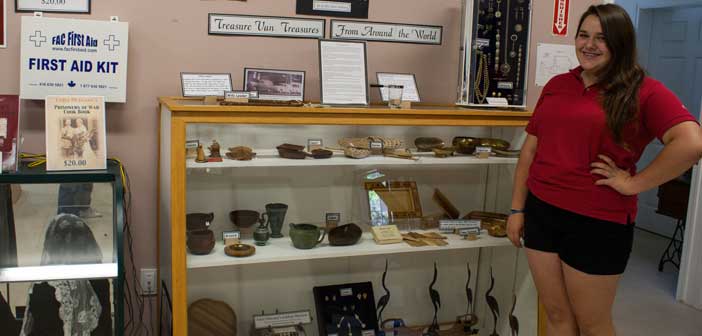MINDEMOYA—The Central Manitoulin Pioneer Museum in downtown Mindemoya opened Wednesday, July 2 with two new exhibits, ‘Treasure Van Treasures’ and ‘School Bus History.’
Treasure Van Treasures tells the story of Ethel Mulvany, whose travels before and after World War II, and her imprisonment as a Japanese prisoner of war at Changi Prison, inspired her to share her experiences in a unique way that improved life in poor villages around the world. “This is my favourite exhibit,” said Alexa Gordon, a summer tour guide at the museum.
“Ethel Mulvany was born on Manitoulin Island, but she liked to travel.” With her husband, Denis, Ms. Mulvany travelled to Singapore from Africa. They were there in 1942 when the Japanese attacked and were both taken as prisoners of war, living in separate prisons for three years. They were reunited after the war but their marriage did not survive.
While in Changi Prison, Ms. Mulvany began her Prisoner of War Cookbook project. After her release, she completed the cookbook and sold 20,000 copies, raising $18,000 which was used to purchase food for former prisoners of war who were still recuperating in hospital in England. Copies of the cookbook can be purchased at the museum and at The Expositor office in Little Current.
During her travels, Ms. Mulvany was bothered by the suffering she encountered and “vowed to do everything possible to stimulate demand for the handmade goods” produced in those poor villages and thus improve the lives of the villagers. She continued to sell arts and crafts while working as a real estate salesperson in Toronto. In 1952, she purchased a van she dubbed the Treasure Van and travelled to universities across Canada selling unique items from over 40 countries. All profits earned through the Treasure Van were used to send Canadian university students abroad and to bring others back to Canada. The Van also served to create awareness and cross-cultural understanding.
The exhibit contains photos and treasures from Ethel Mulvany’s world travels. Ms. Gordon demonstrated a “wife leader” originally used by Carib Indians as a means of leading their wives around and keeping them docile. “It comes off easily,” she explained, “but it hurts if you try to pull your finger away.”
Ms. Gordon stopped in front of a small jar containing tiny carvings. “These are my favourite,” she said. “They’re manchada seeds, from trees in South India. The artists would hollow them out, then place a tiny carved elephant inside.” The elephants are carved from small pieces of ivory, and it took the craftsman about five days to complete each piece.
In addition to jewellery and other treasures, there is a haunting sketch by Ethel Mulvaney of the interior of Changi Prison.
School Bus History uses photos and models to show the progression of school bus transportation in Central Manitoulin, beginning with an early horse drawn, wood heated sleigh van that would have been used in the 1920s and 1930s. In those days, many of the roads on Manitoulin weren’t open for vehicles to travel in winter. It wasn’t until Percy Taylor’s first all-steel bus was introduced that school buses looked anything like they do today. A 1949 photo shows the bus, which held 49 passengers and came with a price tag of $5,600.
The museum has also been refreshed with new display cases. After taking in the permanent exhibits in the brightly lit welcome centre, visitors can tour a log cabin, two pioneer barns and a blacksmith shop, all relocated to Pioneer Museum from local sites. The museum is open daily from 1 to 4 pm.





